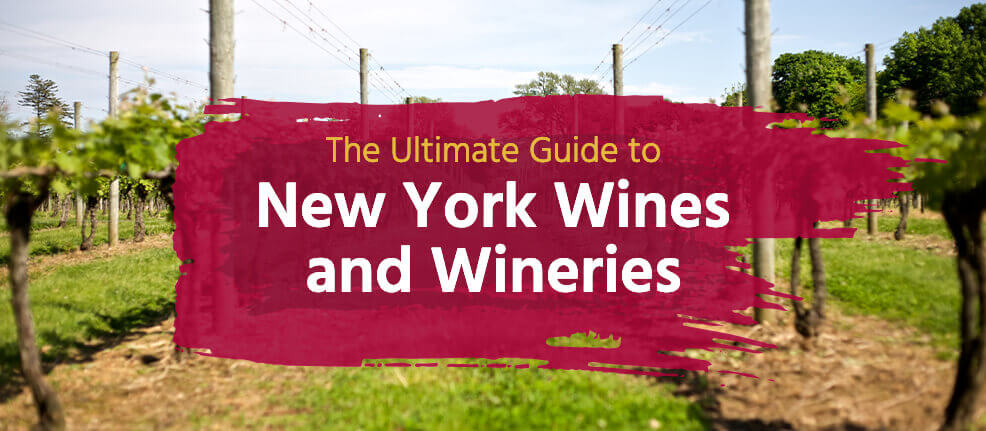
When it comes to American wines, California seems to get all the attention. But those who are laser-focused on Napa and Sonoma are missing out. Upstate New York has quietly earned a reputation for excellent wine, and New York wine country has blossomed into a wonderful tourist destination.
To put New York’s wine industry into perspective, let’s turn to the latest research from the New York Wine & Grape Foundation. There are over 400 wineries and 1,600 New York State vineyards. This results in the production of over 175 million bottles of wine generating $408 million in local and state tax revenues. All told, it’s estimated that the New York wine industry generates $4.8 billion in economic benefits for the state of New York annually.
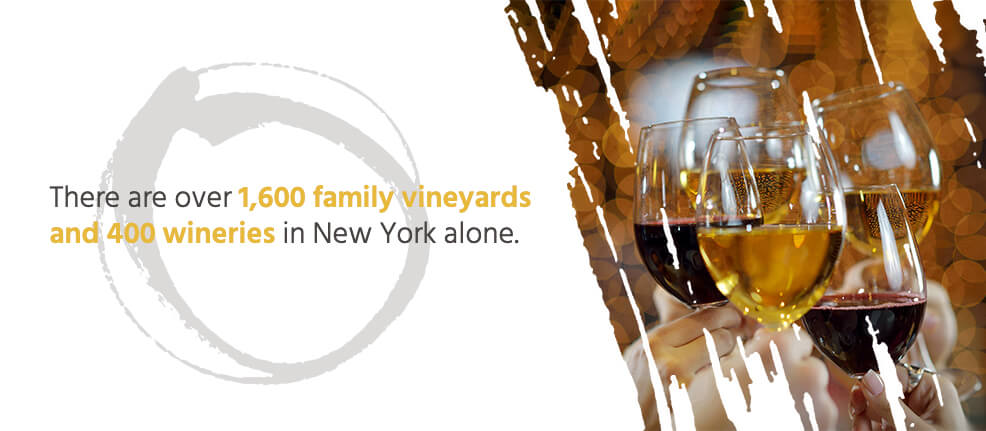
But as any wine lover will tell you, wine isn’t just about business! It’s about an undying love for the fruit of the vine. Quality is more important than quantity and, fortunately, the wineries in New York excel in this sense as well!
Seeing as we know a thing or two about wine, we decided to put together this guide to wineries in New York. Within the guide we will explore the history of grape growing and wineries in upstate NY and Long Island, along with an overview of the various New York wine regions and some of our favorite New York State wines.
So get ready to explore the best wine New York has to offer!
A Quick Note on Grape Species
When talking about wine in New York, it’s important to understand the distinction between the two most prominent species of grape that are grown there. The species of grape native to North American is known as the Vitis labrusca. Some of the most recognized varietals of this grape are Concord and Catawba. While they are popular for the production of grape juice, along with jellies and jams, they are often considered inferior for producing wine. The European species Vitis vinifera is the grape that produces the vast majority of fine wines.
However, Vitis vinifera grapes were not achieved immediately. It took time, patience and trial and error to learn how to grow these grapes in cold outdoor temperatures and rainy conditions. Early attempts to cultivate these grapes in the northeastern United States were unsuccessful, as botanicals were extremely sensitive to these frigid temperatures.
Due to the area’s harsh winters, growing grapes was thought to be impossible here. However, comprehensive trials were performed in the Finger Lakes region of New York, producing results that proved otherwise. After discovering the necessary precautions to protect vines during the cold winter months, the microclimate proved suitable for growing these grapes.
New grape varieties were produced by Cornell University’s Geneva Experiment Station in the late 1900s, dramatically expanding New York State’s wine industry. This included white varieties of Cayuga, Chardonel, Horizon, Melody and Traminette grapes.
Today, many cold hardy grape varieties are grown in the Northeast, Midwest and mid-Atlantic regions of the United States, producing a wide range of flavors for winemaking. This includes Golden Muscat, Alden, Steuben and New York Muscat. Additionally, grape species such as Concord, Niagara, Delaware, Catawba and Diamond are produced from cold-tolerant vines that can withstand this climate.
The introduction of European grapes served as the springboard for the New York wine industry. However, it’s important that we not overemphasize the importance of the distinction, as some winemakers are starting to once again experiment with native grapes. In addition, some growers have also found great success with hybridizing the two species, giving grapes more of the European flavor character while preserving the native grapes’ hardiness in the New York climate.
Although the bulk of New York wines are made with European grapes, don’t write off a native varietal without at least giving it a try!
A Brief History of the Best Wineries in New York State
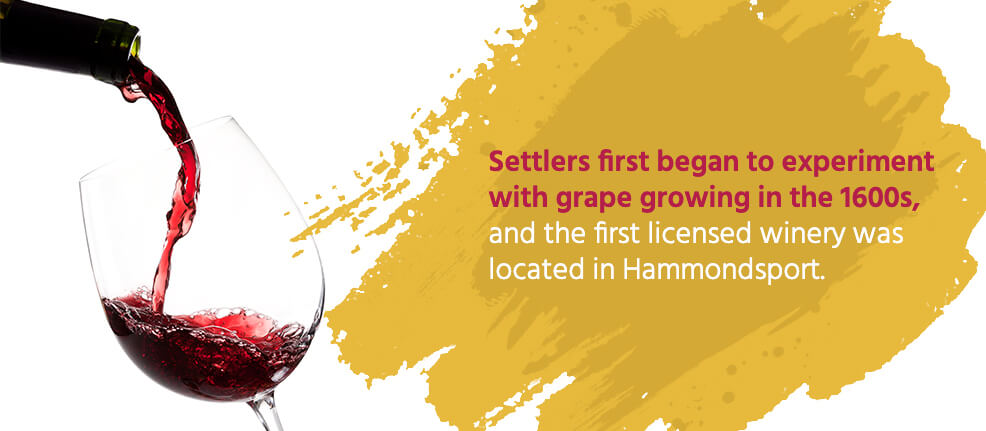
In many ways, American wine making began in New York. Settlers first began to experiment with grape growing in the 1600s, and the first licensed winery was located in Hammondsport. However, the story of fine wine production really begins in the 1950s, when Dr. Konstantin Frank began to experiment with growing famed Old World grape varietals in the Finger Lakes region.
By the 1970s, the success of Dr. Frank’s experiment began to catch on as more wineries began to switch from sweeter juice grapes to the finer European varietals. However, many growers are also sticking to New York tradition and creating fine wines using some of the French-American hybrids that had been earlier dismissed as lower-quality.
Out of this commitment to New York’s rich wine history, melded with bold experimentation, five distinct wine growing regions have emerged, producing some of the best New York wineries: Long Island, the Finger Lakes, Lake Erie, Hudson Valley and the Niagara Escarpment. Each region is earning its own distinct reputation while working together to draw attention to the great wine making being done in New York.
Long Island
Long Island’s wine growing is concentrated on the eastern side of the island. Its emergence as a fine wine region can be traced to the early 1970s, as the first winery opened in 1973.
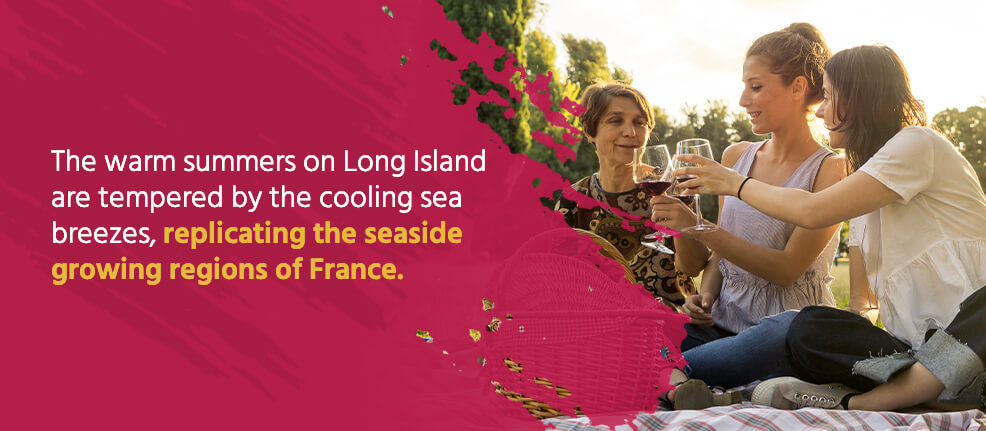
Long Island’s climate has been likened to Bordeaux, so it’s unsurprising that Long Islands vintners have focused on Bordeaux grapes. The warm summers are tempered by the cooling sea breezes, replicating the seaside growing regions of France. As a result, cabernet franc, merlot and sauvignon blanc are the primary grapes being harvested in Long Island. Compared with other wine regions in New York, Long Island gets quite warm in the summer. This is why their Merlots are especially well-regarded. However, the Cabernet Franc should not be neglected. Black pepper is well-balanced with fruity plums and a delicate licorice flavor. In many ways, these are the best cabernet francs outside of the Loire Valley in France.
But if you prefer whites, Sauvignon Blanc and Chardonnay are the most common. The former is probably the better representation of Long Island’s wine making skill.
This is a great region if you like a well-balanced variety of wines. Both strong reds and whites are grown on the island. It’s also a fabulous source of local produce, including asparagus, berries, tomatoes, squash and various root vegetables. This gives the North Fork a complete culinary vision, allowing you to pair excellent wines with fresh ingredients and great food.
As those familiar with Long Island geography will know, the eastern end of the island is divided into two forks. The southern fork is home to the famed Hamptons, where many of the rich and famous of New York spend their summer vacations. As such, much of this land is too expensive to be used for growing grapes. The northern fork, however, is much more affordable — and it’s here that you’ll find the vast majority of Long Island’s leading vineyards.
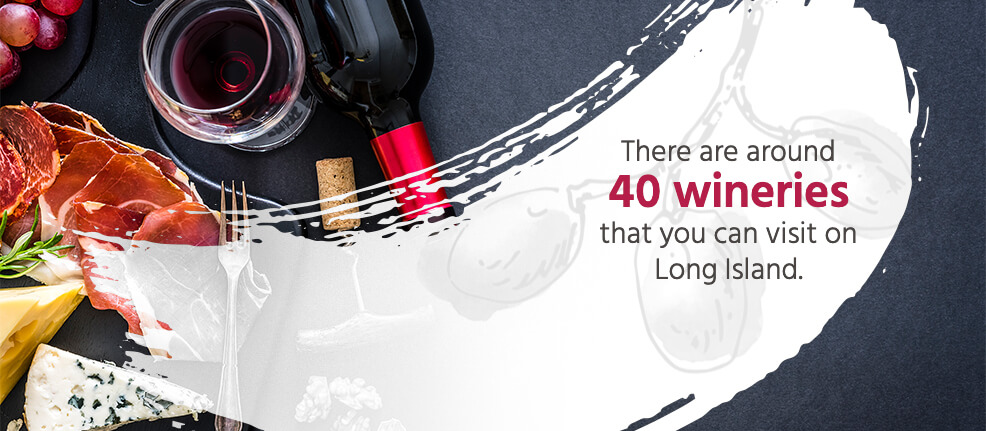
A number of wineries have become popular in Long Island, both for the casual and dedicated wine taster. There are around 40 wineries that you can visit. However, we especially recommend Bedell Cellars, Palmer, Pellegrini, Castello de Borghese, Paumanok, Raphael and Shinn Estate. If you happen to be taking a vacation in the Hamptons, it’s a easy drive to the other fork.
Winery Spotlight — Wolffer Estate Vineyard
Located in the village of Sagaponack on the east end of Long Island, Wolffer Estate Vineyard has been committed to producing premium wines, spirits and ciders since 1988. With private event bookings and tastings, an unmatched passion and appreciation for winemaking and close proximity to the ocean that offers a refreshing breeze, Wolffer Estate is an ideal spot for wine-loving residents and tourists. Taste one of its delicious varieties such as its Summer In A Bottle with notes of fresh raspberry, banana and citrus.
Hudson River Valley
Just as the state of New York started along the Hudson River, so too did New York’s winemaking. This region is home to the oldest winery in the US, the Brotherhood Winery, which was established in 1839. The winery, which only produces sacramental wines used in Christian religious services, was able to survive Prohibition because it was granted a religious exemption. Therefore, while many of California’s wineries closed down at the beginning of the 20th century, forcing the region to restart their wine industry after Prohibition was repealed, the Hudson River Valley continued to thrive.
However, while the Hudson River Valley holds a distinguished position in the American wine making world, on the whole, this is an underused wine growing region.
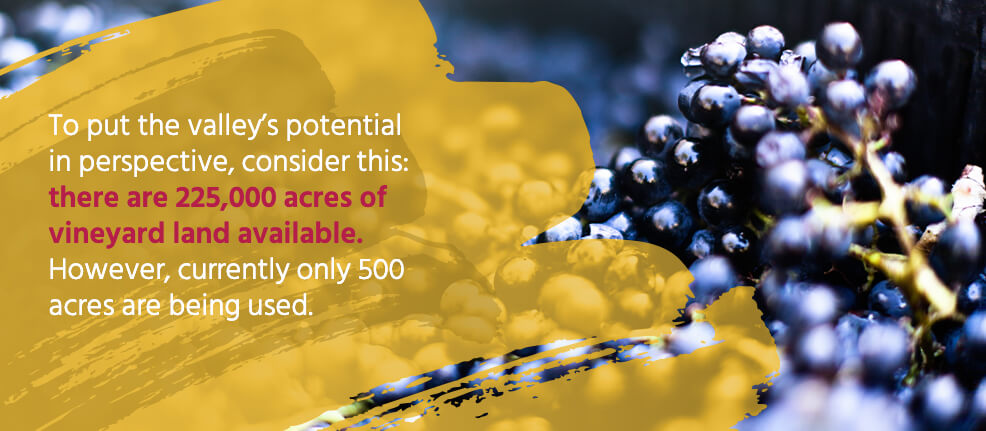
To put the valley’s potential in perspective, consider this: there are 225,000 acres of vineyard land available. However, currently only 500 acres are being used.
That being said, while the Hudson River region has a lot of room to expand, those who do make wine here are committed to their craft. While most of the various wine growing regions in the United States emulate and experiment with Old World grapes, the Hudson River proudly protects its own distinctly American wine making tradition.
As such, the two most representative wines are known as “Heritage Red” and “Heritage White.” While both are blends of older French hybrids, their production is tightly controlled by bylaws.
The region’s many hills help block the vines from the more intemperate cold air further north. Conversely, the river keeps the region cool during the hotter months.
As a wine tourism destination, this is an attractive place to visit, as it’s just a short drive from New York City. And while there may not be a large number of wineries to visit, the ones that do exist are definitely worth the trip. Besides the aforementioned Brotherhood Winery, the Hudson-Chatham Winery, Millbrook and Oak Summit are all excellent places to visit.
Winery Spotlight — Royal Meadery
Royal Meadery is recognized as New York’s first licensed farm meadery and prides itself on sourcing fresh, natural ingredients and local honey. It was originally founded by Gregory Wilhelm, who wanted to combine his passions for brewing and beekeeping.
With the help of one of his college professors, Wilhelm opened his own meadery, a type of winery that produces honey wines. He now runs it with his wife, and together they produce a variety of sweet and delicious varieties such as its Barrel Aged Mead.
The Finger Lakes
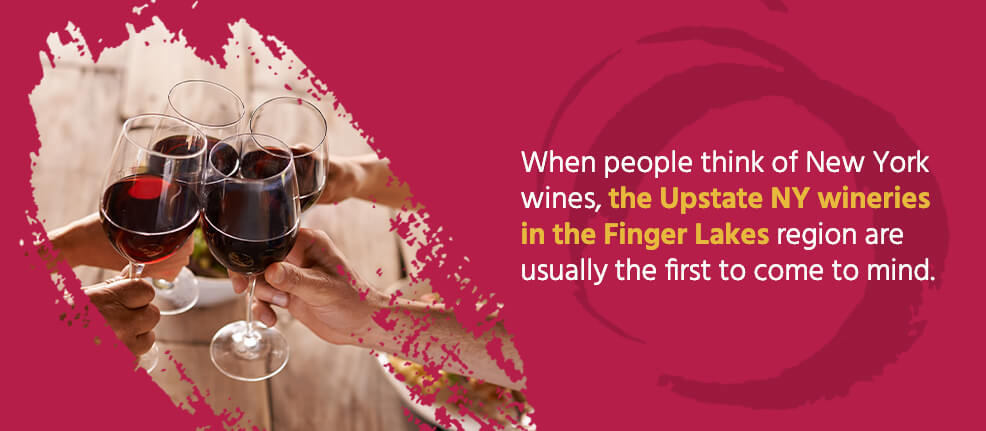
When people think of New York wines, the Upstate NY wineries in the Finger Lakes region are usually the first to come to mind. Of course, when it comes to making fine wine, the Finger Lakes, under the guidance of Dr. Konstantin Frank, started the trend in the state.
Because Dr. Frank was Ukrainian, he had an understanding of the climate of Upstate New York. Often much colder than most wine growing regions, the Finger Lakes have earned a sterling reputation nonetheless, especially in regards to their most famous wine: Riesling.
While the Finger Lakes, created by retreating glaciers, certainly define the region’s geography, they are also crucial for supporting the wine growing climate. The lakes stabilize the temperatures in an otherwise frigid part of the country. Similarly, when the summers grow hot, the lakes keep the region cool, again helping to provide ideal growing conditions for grapes.
The wine in the Fingers Lakes begins and ends with Riesling. They are known for their especially aromatic and dry version of the wine, although many wineries are also creating excellent sweet bottles. They also make excellent Gewürztraminer. However, if you prefer reds, they also have excellent Pinot Noirs and Cabernet Francs.
When traveling through the region, you should always make sure to check out the Dr. Konstantin Frank Winery. Not only is it still run by the founder’s heirs, but it also leads the way in producing the best Riesling in the Finger Lakes. But there’s a lot more than that for you to explore. There are over 11,000 acres of vineyards being used by 130 or so wineries. Agness Wine Cellars, McGregor and Kemmeter are all excellent wineries that also provide great tours and tastings.
There are also a number of distilleries, breweries and excellent eateries in the region, meaning you can combine your tour with a complete culinary experience. Plus, this region — along with perhaps Long Island — has the most developed wine tourism industry in place, meaning you can easily find tours and wine tasting experiences that are designed to make discovering Finger Lakes wine easy for those who are new to tasting.
Winery Spotlight — Bully Hill Vineyards
Located in the heart of the Finger Lakes region, Bully Hill Vineyards is well-known for its outstanding scenery, artistic wine labels and lively winery tours. Its environmentally-friendly packaging practices use recycled glass bottles and boxes, soy-based inks and Tangential-flow filtration to minimize unnecessary disposal.
From sweet reds to strawberry and blackberry-flavored wines, Bully Hill Vineyards features a vast selection of fruits and natural ingredients to produce delicious and authentic flavors. Give these wonderful wines a try!
Lake Erie
This is a traditionally Concord juice grape growing region that has only recently begun to explore the possibilities of fine wine grape growing.
The region is becoming known for its success in growing lesser-known varietals, including the French-American hybrids of Seyval Blanc and Vignoles. In addition, they are working to elevate native grapes, including Catawba, Niagara and Delaware. Like much of New York, Riesling also plays a prominent role in the region’s grape industry.
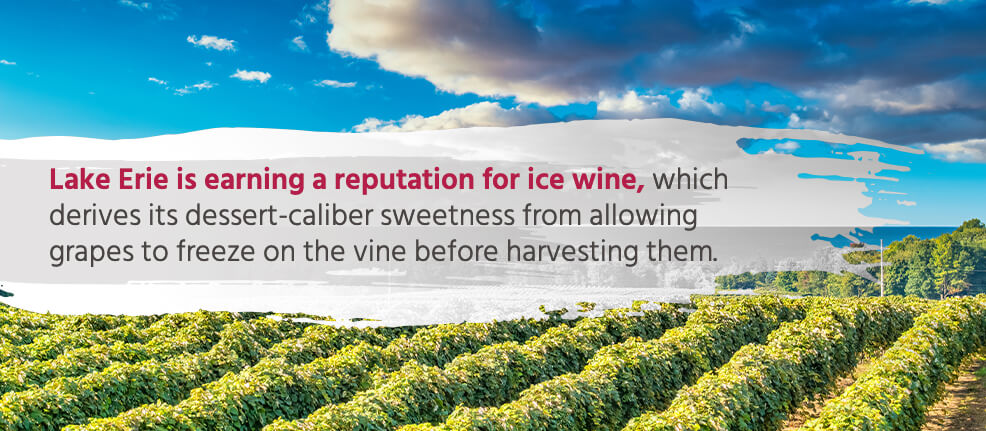
In addition, Lake Erie is earning a reputation for ice wine, which derives its dessert-caliber sweetness from allowing grapes to freeze on the vine before harvesting them.
This is definitely a region with plenty of room to grow. They currently harvest 20,000 acres’ worth of vineyards, although 90% of those grapes are currently Concord.
It should also be noted that this wine region crosses state borders into Pennsylvania and Ohio.
If you’re looking to stay in New York while exploring all that the Lake Erie region has to offer, we suggest checking out 21 Brix Winery. Woodbury Vineyards is also excellent.
Winery Spotlight — 21 Brix
This is a newer winery, having opened its doors in 2011. Winemaker and founder Kris Kane combined his experience on his parents’ farm with a wealth of wine making experience, both domestically and abroad in Australia, to establish 21 Brix as a true up-and-comer.
They offer a wide range of wines, including excellent Rieslings, Pinot Noirs, Cabernet Sauvignons and specialty Vidal ice wines. They also experiment with other fruit wines, such as cherry, blueberry and raspberry. Consider trying an Ella’s White with hints of pear or a Marquis to enjoy the fresh taste of pineapple.
The visitor experience is truly wonderful, as they feature a 60-foot tasting bar, and the winery itself is nestled right along the shore of the lake. They are open daily for tastings, and host a number of special events as well.
Or, if you’re in the area, just keep an eye out for Ella, the life-sized pink elephant that guards the entrance to the winery along Route 20!
Niagara Escarpment
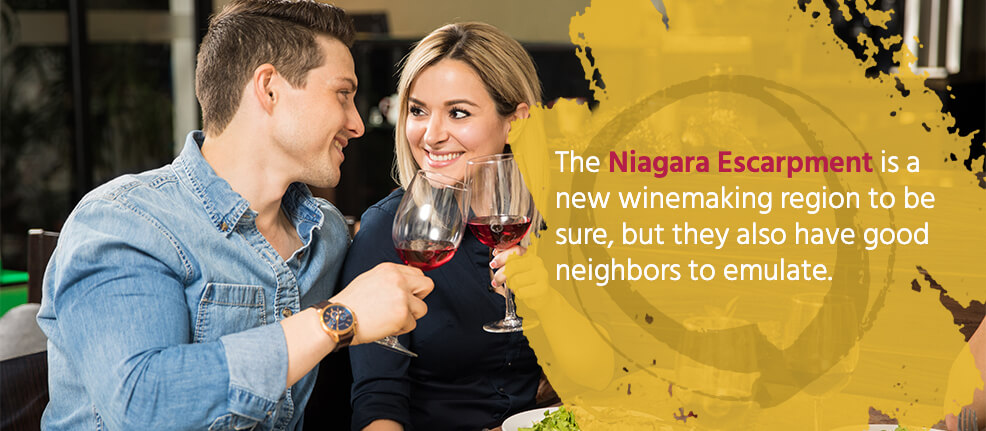
The Niagara Escarpment is a new winemaking region to be sure, but they also have good neighbors to emulate. Ontario has grown in reputation, especially when it comes to ice wine, and Niagara is looking to capitalize on that success.
This is also definitely a small region. Only 800 acres are currently being cultivated, with a total of approximately 15 wineries producing wines. But, in a sense, this plays to their strength. Ice wine can be consistently produced, and the smaller scene means that each winery can focus on doing what they do best.
Furthermore, wine experts are confident that, as Niagara grows in renown, this is a region due for an explosion.
As for wineries worth exploring, Spring Lake and Niagara Landing are both well respected and are a great place to start if you’re looking to get in on the ground floor of this up-and-coming region.
Winery Spotlight — Niagara Landing Wine Cellars
Niagara Landing Wine Cellars was the first winery to open in New York’s Niagara County in over a decade. The winery produces an array of award-winning wines, including a firey hot pepper wine, a popular and intriguing selection with customers.
With delicious samples offered in its own tasting room, statewide wine tasting events and 31 varietals ranging from dry to sweet, it’s no surprise that Niagara Landing brings back visitors time and again. Sip a delicious Loganberry, Raspberry Rosebud or Hot Pepper Sweet Red to drive your tastebuds wild!
Champlain Valley
New York’s Champlain Valley houses over three dozen wineries and vineyards on the Wine Trail. Due to the area’s unique soils and climate, the art of winemaking continues to thrive here each year — winemakers cultivate northern grapes that produce authentic and award-winning wines.
Serving as the border between Vermont and New York State, the region’s beautiful Lake Champlain produces hearty apples and other delicious fruits that thrive abundantly despite the cold climate. It also features cold-hardy “Minnesota” grape varieties among these plantings.
Visit one of Champlain Valley’s local wineries to taste a full-bodied red, elegant dessert wine or dry white made from the region’s lush, locally-grown grapes. No matter what type of wine you’re looking for, you’ll surely find something that satisfies your taste.

Winery Spotlight — Swedish Hill Vineyard & Winery
For over 30 years, Swedish Hill Vineyard & Winery has offered an extensive selection of wine products. Its wines range from very dry to very sweet and are available in multiple types, styles and flavors, providing something for everyone to enjoy no matter their preferred variety. Visit this lovely winery to browse its gift shop, enjoy its picnicking spots or taste one of its delicious wines. Whether you prefer a classic Riesling or a rich Svenska Red, you’ll surely find something here to treat your tastebuds.
Your Wine Tour Begins Now!
We hope this tour through New York wine country has given you a glimpse into just how wonderful East Coast American wines can be. You don’t have to go to California or even France just to get a taste of the best fruits of the vine!
Whether you’re looking for a day trip out of the city or a more in-depth vacation in New York wine country, there are a number of excellent wineries throughout New York’s five main winemaking regions.
And, of course, for the rest of your wine purchasing needs, check out our cellars at Marketview Liquor.

We have one of the largest selections of New York wines available under one roof – available online or for pickup at our Rochester NY location following your wine tour. We take wine seriously, and we’re always here to connect you with your new favorite bottle.
Use our online store to search by region, grape varietal, free shipping, case discounts, or even price, making it simple for you to find the perfect wine for your tastes.
So raise a glass to all the great wine that New York has to offer. We look forward to sharing a toast with you!
